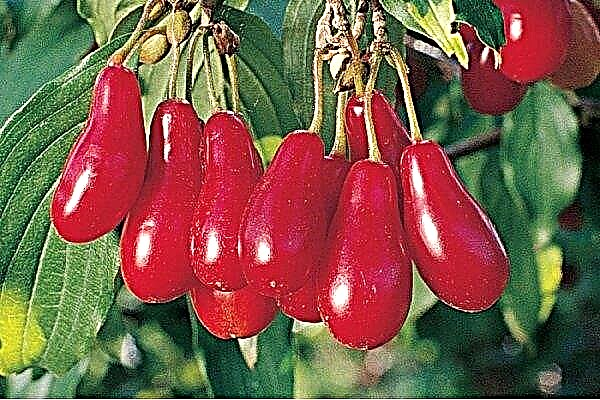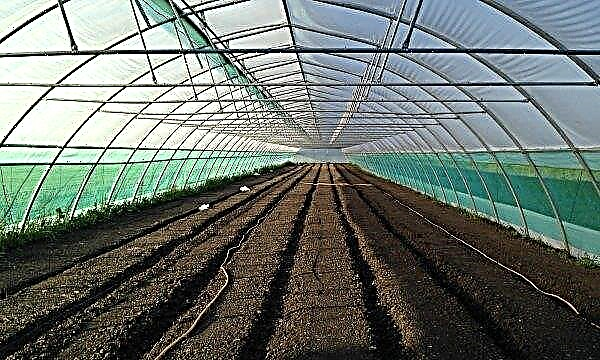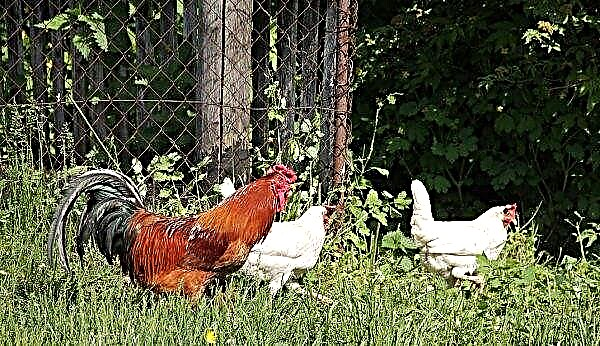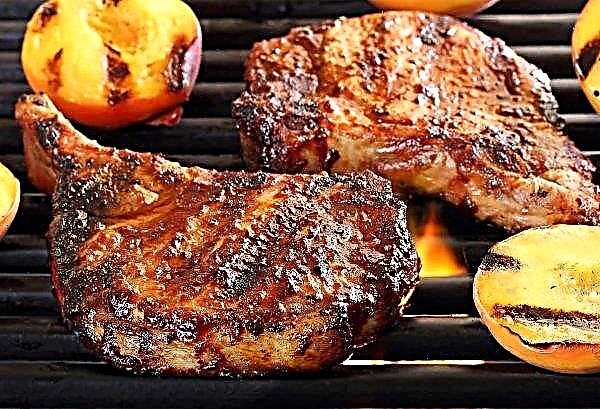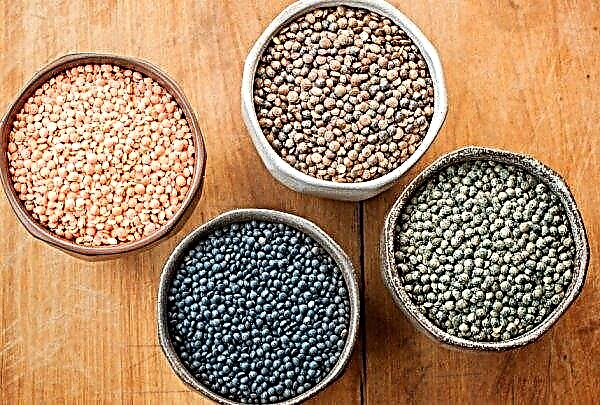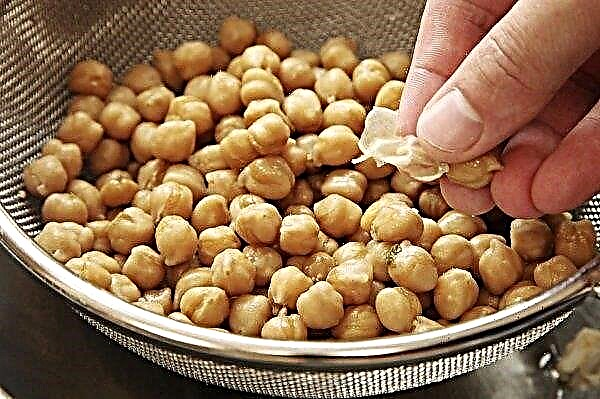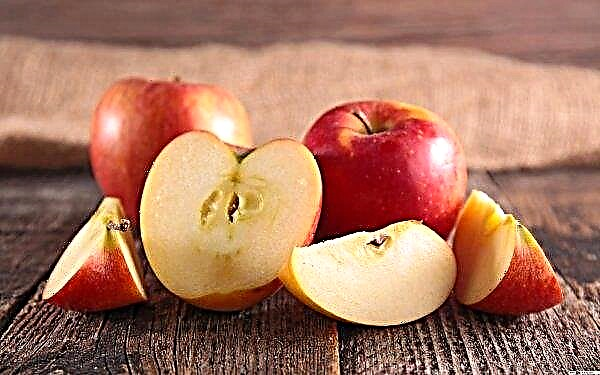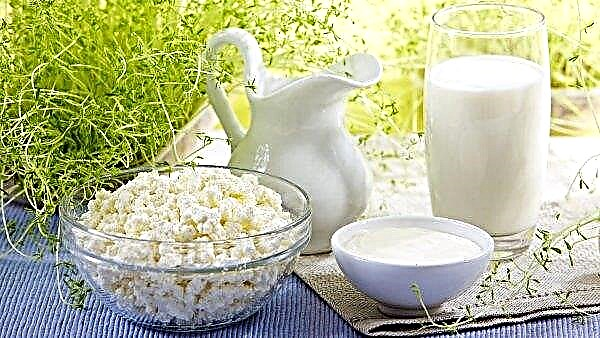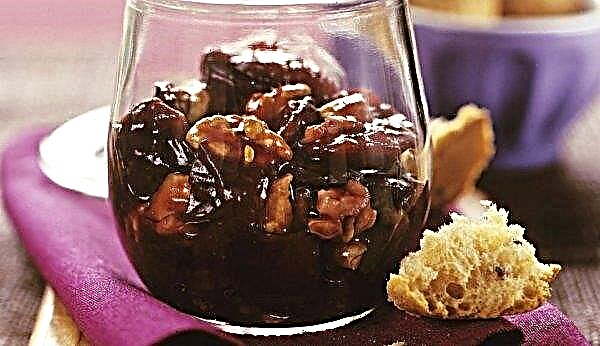In choosing potatoes for planting, farmers prefer unpretentious cultivars that have high technical and productive characteristics. One of these varieties is Granada, its description and agricultural production technique are presented in the article.
Variety Description and Characterization
The new variety was bred by German breeders in 2015. For several years, Granada has gained popularity among vegetable growers from Western European countries, Ukraine, Belarus, in central Russia.
The bush is low up to 60 cm, with straight stems, medium leaf. By maturity dates, it belongs to medium-late varieties; after planting, an average of 110 days elapses before harvesting. Inflorescences are white, foliage is light green.Did you know? In one of the advertising photo shoots, Marilyn Monroe posed for the photographer in a dress sewn from a potato bag. Inspired by such an advertisement, a farmer from Idaho sent the actress as a gift a bag of selected tubers.
The mass of the tuber is 100 g, the shape is oval, the surface is even with shallow eyes. Stable productivity with 1 m² harvest 6.5 kg of fruit. Tubers tolerate long-term transportation, have good storage performance: only 3% of waste.
Thin peel of light yellow color, creamy flesh. Potatoes do not boil, do not darken during cooking. The taste is pleasant, without the presence of stickiness, the starch content is about 17%.

Advantages and disadvantages
In the work on the variety, breeders took into account many factors affecting the yield of potatoes.
- Among the advantages of the variety:
- stable yield;
- drought tolerance;
- good storage performance;
- shape preservation during heat treatment;
- resistance to diseases and pests.
- With proper care, Granada resists solanaceous diseases such as:
- scab;
- root rot
- crayfish.
The disadvantage of some vegetable growers consider sensitivity to organic fertilizers. With an excess of nitrogen, the tops grows very much and stretches up.
Planting and growing potato varieties
The selection of the seed of the Granada variety is different in that it is important to select large tubers. Selected potatoes from well-bearing fruit bushes are taken for seeds.
Optimal timing
The approximate landing time is the end of April. The main condition is soil temperature not lower than + 8 ° С.

Crop rotation rules
When cultivating the variety, there will be no difficulties with diseases or pests, if you strictly observe the rules of crop rotation.
Recommended Scheme:
- Divide the garden into three sections.
- Take one plot for potatoes, sowing green manure in the fall.
- Before the onset of frost, mow and dig the plot along with straw to a depth of 15 cm.
- The second plot is planted with root crops or gourds.
- The third bed - legumes.
- From year to year, the cultures in the areas follow each other in a circle.
- Such a scheme does not allow the soil to deplete and does not attract the main pests of the garden.
Soil requirements
The variety is undemanding to the composition of the soil, but the method of planting tubers depends on it. In the southern regions on light soils they land in furrows or pits. Planting depth - 10-12 cm.
On dense clay lands, planting is carried out to a depth of 5 cm, and ridges must be made.
Mowed siderates are embedded in the soil, which loosens it and saturates it with nutrients.
Preparing planting material
Selected seed material must be decontaminated.
To protect tubers from infections and insects, a mixture of preparations is prepared per 1 liter of water:
- copper sulfate 0.2 g;
- potassium permanganate 0.1 g;
- boric acid 15 g.
Another treatment option is dressing in a purchased fungicide, for example, Fitosporin. To spray the seeds, a solution is prepared: 20 g / 10 l of water.
Treated tubers are placed in germination in a mixture of peat and garden soil in equal parts.Important! Combination of “Fitosporin” with preparations containing copper is not recommended: the active substances are incompatible.
Landing pattern
Sprouted potatoes must have at least three “awakened” eyes.
Landing technology:
- The distance between the holes is left up to 30 cm, between the rows up to 70 cm.
- The well is moistened before planting.
- At the bottom of the pit is placed 100 g of wood ash.
- Seeds cover with soil, do not water.

Features of potato care after planting
Potatoes do not like waterlogging, moreover, it is resistant to drought. With this in mind, watering is carried out about 3 times per season, using standing water. The first procedure is necessary for young sprouts immediately after germination. The soil should be moistened to a depth of half a meter. The following two procedures are carried out before flowering (when the buds appear) and after it. If the season is rainy with good rainfall, watering is not carried out.
As soon as the bushes reach a height of 14–16 cm, they need to be hilled. Hills form around the bush, covering the stems to the foliage. Such a manipulation will protect the roots from overheating and give a neat shape to the bush. Simultaneously with the earthing up, it is recommended to weed the area from weeds. A second hilling is necessary before flowering begins.
The first fertilizer is needed in the culture a month after planting.
The mineral complex is used in liquid form, for 10 liters of water they take:
- urea - 10 g;
- potassium sulfate - 10 g;
- superphosphate - 20 g.
Important! Organics, especially fresh manure, are detrimental to Granada — active nitrogen can burn the root system.
For the second top dressing, potassium sulfate and double superphosphate are mixed in 10 g / 10 l of water. Carry out the procedure during flowering, when the tubers begin their formation.
The third top dressing is needed to enrich the future crop with useful elements that will allow it to be stored for a long time and improve palatability. For this, foliar top dressing with superphosphate is used. Planting is sprayed with a solution of 100 g / 10 l of water.
Diseases and Pests
Potato Granada, possessing immunity from many diseases of solanaceous crops and pests, can be affected by Fusarium and Colorado potato beetle.
Fusarium - fungal disease, the ideal environment for development is excess moisture. The main symptom is that the leaves turn pale and curl up with a boat. A disease can destroy an entire landing in a matter of days. In addition to developing plants, the fungus is capable of destroying the crop in storage. As a prophylaxis, tubers are treated with Fitosporin before planting, the second prophylactic manipulation is carried out before flowering with the same preparation.
Before planting during spring digging of the soil, it is sprayed with the “Quadris” preparation (5 ml / 10 l), which remains effective throughout the growing season. Before sending to the storage, the room is treated with a solution of bleach 2 kg / 10 l of water. Tubers before laying for storage are treated with Fitosporin 20 g / 10 l.
Colorado beetle - Dangerous adults and larvae gnawing the green parts of plants. An effective means of pest control is the drug "Bushido". With a solution of 0.5 g / 10 l of water, the planting is sprayed in calm, clear weather.
For prevention, plants are planted in the aisles that secrete phytoncides that repel the insect:
- nasturtium;
- calendula;
- marigold.
Did you know? In 1845, as a result of the massive defeat of potato fields by late blight in Ireland, famine began, lasting four years. Over a million Irish people during this time of starvation preferred emigration.
Harvesting and storage
Depending on the timing of planting, the crop is harvested in mid-late August. Gently deepen the shovel under the bush to the length of the bayonet and pick up the tubers. If the soil is wet during harvesting, the tubers are left to dry in the aisles, after which it is easier to shake off the remaining soil from them.
Tubers selected for seeds are left for landscaping. In rainy weather - under a canopy, in dry - under the sun. The duration of the process is 10-12 days. During this time, the tubers will be filled with solanine, which will protect them from diseases and pests.
After drying and cleaning from the ground, table potatoes are sent for storage to the cellar, dry, ventilated with a temperature of + 2 ... + 4 ° С. Granada has been stored for more than six months without loss of taste. From time to time, vegetables are inspected and spoiled removed.
Granada is a high-quality potato variety worthy of attention of both large-scale farming and the summer resident. All that is needed to grow a wonderful crop without difficulty is compliance with crop rotation and agricultural technology.


